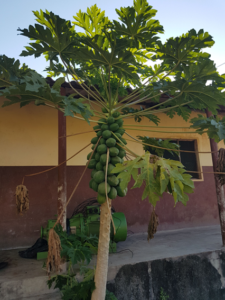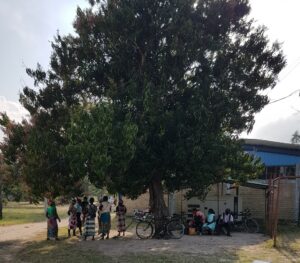Make Your Experiences Count. They Can Change the World.
LET’S BRING ALL OF OUR KNOWLEDGE AND EXPERIENCES TOGETHER.
TOGETHER WE KNOW MORE. TOGETHER WE ACHIEVE MORE. TOGETHER WE DO BETTER.
LET’S BRING ALL OF OUR KNOWLEDGE AND EXPERIENCES TOGETHER.
TOGETHER WE KNOW MORE. TOGETHER WE ACHIEVE MORE. TOGETHER WE DO BETTER.
Published: July 21, 2022
Young Africa Agri-Tech (YAAT) is an agricultural training centre for disadvantaged youths located in Dondo, Sofala Province. It is part of Young Africa Mozambique and currently has an average of about 350 enrolled students. The YAAT farm is producing vegetables, maize, rice, beans etc. as well as slaughter chicken, eggs, pigs and milk. We also operate a mill, a brick production and a milk processing unit. We train our students in practical skills as well as producing some food and generating income to cover some of the operating costs of the institution.
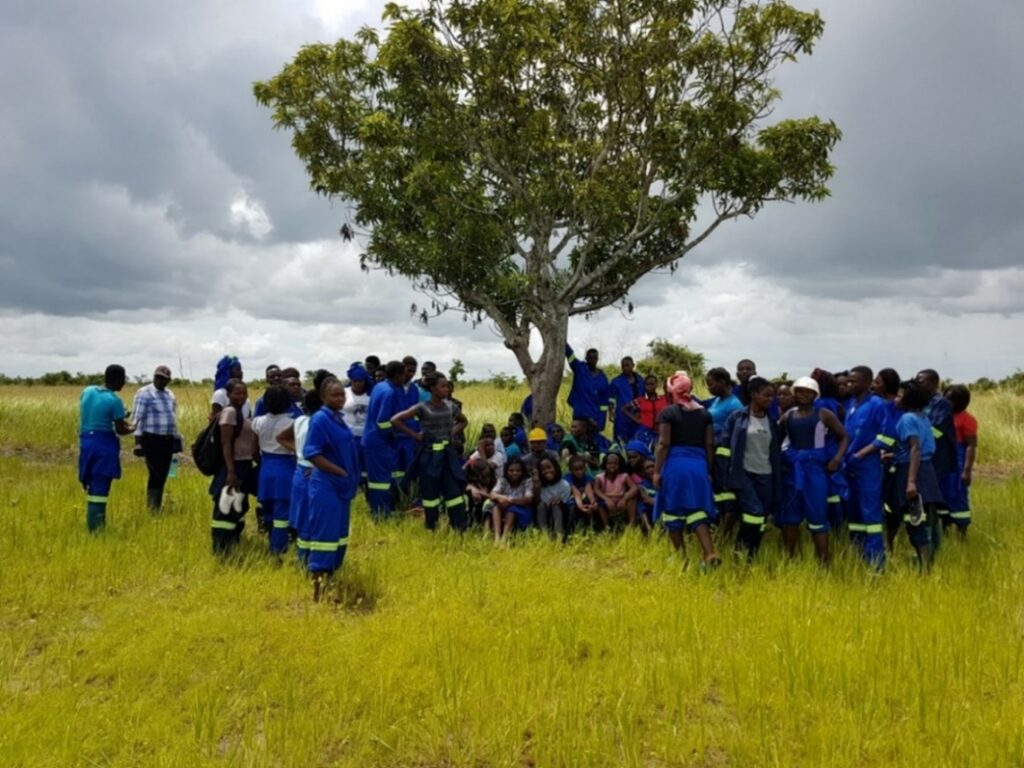
We train disadvantaged, vulnerable and handicapped Youths between the ages of 15 to 25 years to offer them vocational training so that they are able to compete on the job market or to start their own business. Our program is nationally accredited by ANEP (National Authority for Professional Education) and offers agriculture, horticulture, aviculture and related disciplines such as construction, photovoltaic, electrical installation courses of 6-12 month duration.
We have recently decided to put some emphasis on re-establishing trees and replace some of those, which had been cut over the years. More shade is also badly needed here on the farm, especially on larger fields and on the school campus. The tropical climate, combined with increasing global warming, makes shade trees more and more important.
Trees also serve many other useful purposes such as fruit production, sustainable land use, biodiversity and not to forget, motives for painters and photographers. Trees protect the soil and fruit trees can be a form of regenerative agriculture. We started the project with eucalyptus trees, mangoes, bananas, and a few papaya trees. More species will follow.
Most species of Eucalyptus are native to Australia. From the 19th century onwards, Europeans introduced them to many parts of the world for the use in industrial tree plantations – regardless of their impact on local environmental and socioeconomic contexts. Nowadays, many Eucalyptus trees are growing here in Mozambique.
Wildfire is not only a feature of Australia but also of southern Africa, and many eucalypt species are adapted to that from their native Australia: they resprout or have seeds that survive such fires. Eucalyptus oil, however, is itself highly flammable (ignited trees have been known to explode). Bushfires can thus travel easily through the oil-rich air of the tree crowns.
We had a lot of problems with man-made fires (to clear land for planting crops) spreading from small farms to YAAT land and also burning our Eucalyptus plantation. While some eucalyptus trees perished, most survived, it is important not to plant them too densely. Trees well distributed over the farm don’t pose much of a hazard.
Eucalypts are grown in plantations in many parts of the world now because they are fast growing and have valuable timber, can be used for honey production or essential medicinal oils. The leaves are often used to treat coughs and a cold.
It is often said that Eucalyptus trees require too much water, which is seen as a disadvantage where rainfall is scarce. They root deeply in dry areas to reach water even from great depth. While we do have some problems with water to irrigate land, this is rather due to technical issues. The farm has more problems with waterlogging and swampy ground conditions. Thus, the water requirement of Eucalyptus does not constitute a problem here, it is rather an advantage as they help to remove some excess water from the soil by transpiration. At the same time the trees provide wood, medicinal leaf oil, shade, wind breaks, resting places for birds and some control of soil erosion.
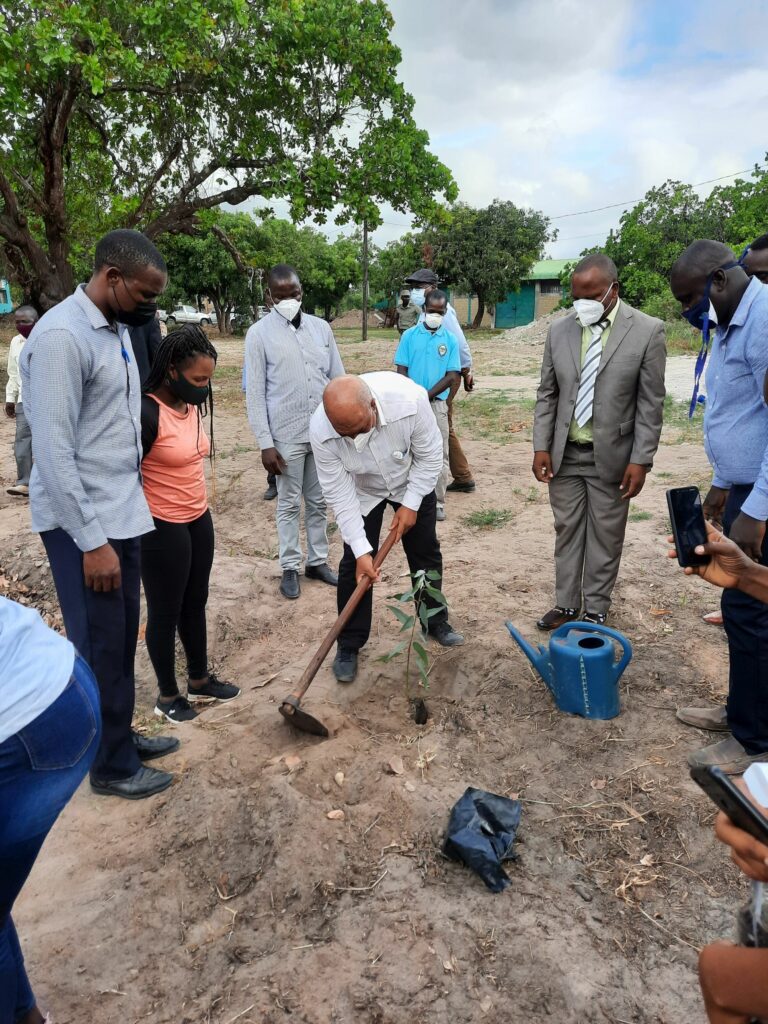
The planting of eucalyptus trees is celebrated by asking visitors, especially NGOs, donors, and government officials to plant a tree during their visit and to have their photos taken. We even had news channel cameras recording some events as was the case when the governor of Sofala and the administrator of the Dondo district planted a Eucalyptus tree each. A plaque is usually added to commemorate the act. Such pictures get published here and there and show commitment to regenerative agriculture, to combat desertification, climate change etc.
One of the fruit species which grows well in many parts of Mozambique is the mango tree. Wherever natural trees are missing, mangoes keep growing. Many have been planted by small farmers and gardeners, but due to their abundance, fruits fall to the ground and seeds sprout naturally thus ensuring their spread of the species.
Most of the trees are of the wild types rather than improved cultivars. Many have rather small fruits which are not commercially viable, but these trees are well adapted to the climate of Sofala. People pick the fruits and eat them even while still green and some of the bigger ones are often sold locally by street vendors. Quite a few mango trees are kept at YAAT and some of the fruits are processed into mango juice at our food & milk processing centre. There is a demand for fresh mango juice, and we sell a few litres per week, when in season. Mango trees grow to a substantial height, thus apart from the fruits, they provide a lot of shade. The trees are long-lived, some specimens still fruit after 300 years.
YAAT decided to grow many more mango trees as a second species to augment our tree planting efforts and taking a long-term view towards regenerative practices. Mango plants are easy to get here, and we already had quite a few in the nursery. They rarely fail once transplanted. With time they become ideal shade trees which can survive droughts and storms. On December 30, 2021 YAAT organized a “Day of the Mango” and with the help of some of our students a dozen new trees were planted to initiate this activity. More will be planted soon.

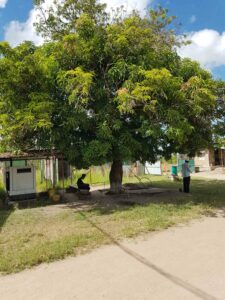
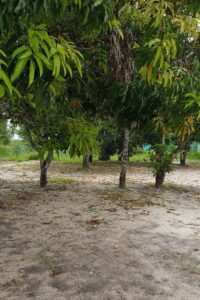
There is the common misconception that banana plants are trees. This is not so, as they are monocotyledous herbaceous plants (grass) and their stem (rhizome) is underground. What you see above the soil appears like a tree trunk. This is just part of their leaf stalks (petioles) which together form a so called pseudostem. Bananas belong to the order of Zingiberales (ginger) and the family Musaceae. Apart from the well know sweet fruit they are also found as a starchy cooking banana (plantain).
Here in Dondo many bananas are grown for home use and sold in road stalls. Most are of the wild type; few people have access to commercial cultivars and just multiply the local varieties which usually only have small bunches, few hands and small fruits. They are however very tasty and popular.
We also planted some 25 banana trees next to our stream and while we do not expect much shade from them, we can probably harvest a few bunches for the use of our students. Don’t expect to have the “Mr. Tally Man” bananas with their “6-foot, 7-foot, 8-foot bunch”. It’s more like a 2-foot bunch we find here.
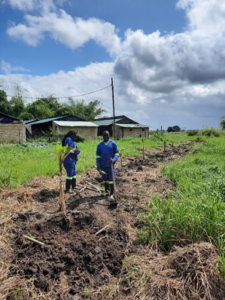

We also find other fruit trees in this area which are popular and grow well such as cashew nuts, papaya, avocado, guavas, oranges, lemons and others. We plan to plant more of those as well to have a good variety for our students to see.

